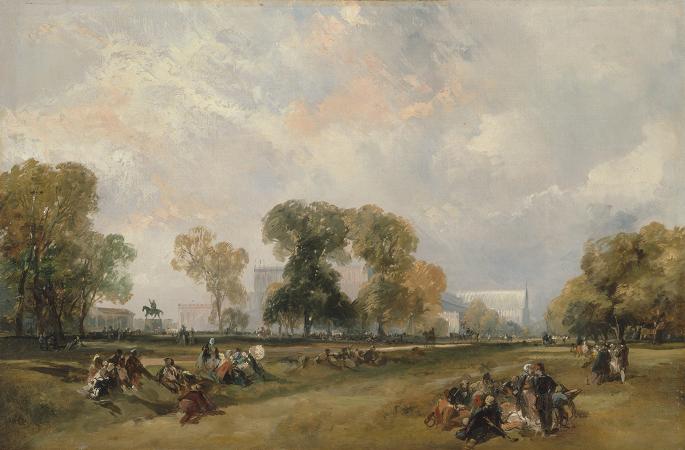William Gilpin (1724 - 1804). William Gilpin was an English artist, Anglican cleric, schoolmaster and author. He is best known as one of those who originated the idea of the picturesque. Gilpin was born in Cumberland, the son of Captain John Bernard Gilpin, a soldier and amateur artist. From an early age he was an enthusiastic sketcher and collector of prints, but while his brother Sawrey Gilpin became a professional painter, William opted for a career in the church, graduating from Queen's College, Oxford in 1748. While still at Oxford, Gilpin anonymously published A Dialogue upon the Gardens. at Stow in Buckinghamshire. Part guidebook to Stowe, part essay on aesthetics, this shows that Gilpin had already begun to develop his ideas on the picturesque. Unusually for the time, Gilpin showed an appreciation of wild and rugged mountain scenery, perhaps rooted in his Cumbrian upbringing. Even more unusually, he expressed ideas about the perception of beauty which were purely aesthetic and often divorced from other qualities of the object viewed, such as morality or utility. After working as curate, Gilpin became master, and from 1755 headmaster, at Cheam School. He was an enlightened educationalist, instituting a system of fines rather than corporal punishment and encouraging the boys to keep gardens and in-school shops. His broad intention was to promote uprightness and utility and give his pupils a miniature of the world they were afterwards to enter. Gilpin stayed at Cheam until 1777, when he moved with his wife Margaret to become Vicar of Boldre in the New Forest in Hampshire. While there he took as a child pupil the future poet Caroline Anne Bowles. Another pupil was his nephew, the painter William Sawrey Gilpin. He was succeeded at Cheam by his son, another William Gilpin. William Gilpin died at Boldre, Hampshire, on 5 April 1804 and was buried there on 13 April. He was survived by his wife, Margaret, to whom he was married for over 50 years. His older son, John Bernard, became British Consul for Rhode Island. His younger, William, had taken over at Cheam School. His two daughters predeceased him. In 1768 Gilpin published his popular Essay on Prints where he defined the picturesque as 'that kind of beauty which is agreeable in a picture and began to expound his principles of picturesque beauty, based largely on his knowledge of landscape painting. During the late 1760s and 1770s Gilpin travelled extensively in the summer holidays and applied these principles to the landscapes he saw, committing his thoughts and spontaneous sketches to notebooks. Gilpin's tour journals circulated in manuscript to friends, such as the poet William Mason, and a wider circle including Thomas Gray, Horace Walpole and King George III. In 1782, at the instigation of Mason, Gilpin published Observations on the River Wye and several parts of South Wales, etc. relative chiefly to Picturesque Beauty; made in the summer of the year 1770. This was illustrated with plates based on Gilpin's sketches, etched by his nephew William Sawrey Gilpin using the newly invented aquatint process. There followed Observations on the Lake District and the West of England and, after his move to Boldre Remarks on Forest Scenery, and other woodland Views. Gilpin's watercolour technique has been compared to that of Alexander Cozens. Both texture and composition were important in a correctly picturesque scene. The texture should be rough, intricate, varied or broken, without obvious straight lines. The composition should work as a unified whole, incorporating several elements: a dark foreground with a front screen or side screens, a brighter middle distance, and at least one further, less distinctly depicted distance. A ruined abbey or castle would add consequence. A low viewpoint, which tended to emphasise the sublime, was always preferable to a prospect from on high. While Gilpin allowed that nature was good at producing textures and colours, it was rarely capable of creating the perfect composition. Some extra help from the artist, perhaps in the form of a carefully placed tree, was usually required. In contrast to other contemporary travel writers, such as Thomas Pennant, Gilpin included little history, and few facts or anecdotes. Even Gilpin's descriptions can seem quite vague, concentrating on how scenery conformed to picturesque principles rather than its specific character. In one much-quoted passage, Gilpin takes things to an extreme, suggesting that a mallet judiciously used might render the insufficiently ruinous gable of Tintern Abbey more picturesque. In the same work he criticises John Dyer's description of the view from Grongar Hill for describing a distant object in too much detail.
more...













